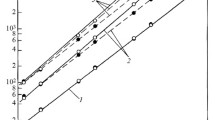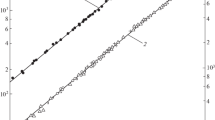Abstract
Experimental data on heat transfer and friction in the presence of a bypass laminar-turbulent transition in a flow with an increased degree of turbulence Tue=3.2–7% are reported. It is shown that several types of bypass transition can occur depending on the turbulence scale: from laminar to turbulent, from pseudolaminar to quasiturbulent, and combination. It is established that the mechanism of the transition is related to the selective properties of the wall boundary layers developed in its presence. A tendency toward the development of an upper thermal transition in turbulized flows is established.
Similar content being viewed by others
References
Y. S. Kachanov, Ann. Rev. Fluid Mech.,26, 441–481 (1994).
J. Kestin, Adv. Heat Transfer, 3, 1–32 (1966).
E. P. Dyban and V. D. Kurosh, “Comparative study of the heat transfer of a nozzle blade profile in a wind tunnel and in an air turbine,” NASA TT-F-16060 (1968).
E. P. Dyban and É. Ya. Épik, in: Near-Wall Turbulent Flow [in Russian], Pt. 2, Kiev (1975), pp. 25–34.
E. P. Dyban, É. Ya. Épik, and T. T. Suprun, Teplofiz. Teplotekh., No. 30, 86–90 (1976).
E. P. Dyban and É. Ya. Épik, Heat-Mass Transfer and Fluid Dynamics of Turbulized Flows [in Russian], Kiev (1985).
V. S. Kosorygin, N. F. Polyakov, T. T. Suprun, and É. Ya. Épik, Instability of Sub- and Supersonic Flows [in Russian], Kiev (1982), pp. 85–92.
M. Morkovin, “Bypass transition to turbulence and research desiderate,” NASA Conf. Publ. 2386 (1985).
R. E. Mayle, ASME J. Turbomachinery,113, 509–537 (1991).
P. E. Roach and D. H. Brierlay, Numerical Simulation of Unsteady Flows and Transition to Turbulence, Cambridge (1992), pp. 310–347.
M. Savill, Engineering Turbulence Modeling and Experiments (1993), pp. 310–347.
E. P. Dyban, E. Ya. Epik, T. T. Suprun, and S. V. Kuimov, in: Int. Symp. on Turbulence, Heat and Mass Trans.,2, 1.12.1–1.12.4 (1994).
M. F. Blair, Trans. ASME, J. Heat Trans.,105, 33–47 (1983).
M. F. Blair, Fluids Eng.,114, 313–332 (1992).
K. H. Sohn, J. F. O'Brien and E. Reshotko, in: Proc. 7th Symp. on Turbulent Shear Flows (1989), pp. 2.4.1–2.4.6.
F. J. Keller and T. Wang, ASME 93-GT-67 (1993).
C. L. Kuan and T. Wang, Exp. Thermal Fluid Sci.,3, 157–173 (1990).
T. Wang, T. W. Simon, and J. Buddhavarapu, J. Eng. Gas Turbines Power,107, 1007–1015 (1985).
D. Zhou and T. Wang, ASME 93-GT-66 (1993).
P. E. Hancock and P. Bradshaw, Trans. ASME, J. Fluids Eng.,105, 284–289 (1983).
E. P. Dyban and E. Ya. Epik, Near-Wall Turbulence, Hemisphere Publ. Corp. (1989), pp. 139–155.
B. J. Abu-Ghannam and R. Shaw, J. Mech. Eng. Sci.,22, 213–218 (1980).
Additional information
Deceased.
Institute of Technical Thermophysics, National Academy of Sciences of Ukraine, Kiev, Ukraine. Translated from Inzhenerno-Fizicheskii Zhurnal, Vol. 69, No. 6, pp. 958–964, November-December, 1996.
Rights and permissions
About this article
Cite this article
Dyban, E.P., Épik, É.Y. Heat transfer involving the laminar-turbulent transition and the enhanced turbulence of an external flow. J Eng Phys Thermophys 69, 726–733 (1996). https://doi.org/10.1007/BF02606106
Received:
Issue Date:
DOI: https://doi.org/10.1007/BF02606106




